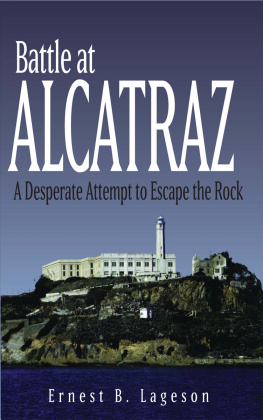Alcatraz David Ward Gene KassebaumUniversity of California Press (2009)
Rating:Tags: United States, General, History
Al Capone, George "Machine Gun" Kelly, Alvin Karpis, "Dock" Barker--these were just a few of the legendary "public enemies" for whom America's first supermax prison was created. In Alcatraz: The Gangster Years, David Ward brings their stories to life, along with vivid accounts of the lives of other infamous criminals who passed through the penitentiary from 1934 to 1948. Ward, who enjoyed unprecedented access to FBI, Federal Bureau of Prisons, and Federal Parole records, conducted interviews with one hundred former Alcatraz convicts, guards, and administrators to produce this definitive history of "The Rock." Alcatraz is the only book with authoritative answers to questions that have swirled about the prison: How did prisoners cope psychologically with the harsh regime? What provoked the protests and strikes? How did security flaws lead to the sensational escape attempts? And what happened when these "habitual, incorrigible" convicts were finally released? By shining a light on the most famous prison in the world, Ward also raises timely questions about today's supermax prisons.
Review
"Enjoyable as well as informative. Anyone who has read it is unlikely to look upon the Rock quite the same way ever again."-- San Francisco Chronicle
"Alcatraz, as David Ward has re-created it, is irresistible to read about."-- California Lawyer
"Alcatraz: The Gangster Years deserves a place in the library of anyone or institution."-- California Historian
From the Inside Flap
"Ward has collected the most impressive documentation anywhere on the workings of a prison. A unique and wonderful work of sociology and history."--Howard Becker, author of Outsiders: Studies in the Sociology of Deviance and Art Worlds
"This groundbreaking history of the country's most notorious prison is the first to give an in-depth analysis of the interaction between the guards and the prisoners. Ward captures the Alcatraz experience with the accuracy of someone who has practically been there and lays to rest many of the myths that have grown up around the prison. No longer will the story-tellers be able to describe the inmates as 'the worst of the worst' without qualification. Their individual stories come alive as the author records the varied life experiences that brought them to Alcatraz and describes their coping mechanisms. A unique and fascinating study."--Morton Sobell, Alcatraz Inmate #AZ699 1950-1963, author of On Doing Time

ALCATRAZ

The Alcatraz Revolt, May 2, 1946 (see ). 1. Coy and Hubbard capture Officer Miller and take his keys. 2. Hubbard releases Cretzer, Carnes, and Thompson. 3. Hubbard and Coy climb cage protecting armed officer and spread bars. 4. Coy captures Officer Burch and throws pistol to Cretzer. 5. Coy forces officer to open door between D block and main cell block. 6. Cretzer liberates thirty prisoners. 7. Reserve officers enter main cell house. 8. They are locked in a cell and later shot by Cretzer. 9. Coy attempts to shoot tower officer. 10. Officers block escape at rear of main cell house. 11. Marines guard prisoners in recreation yard. 12. Officers break through roof and drop grenades and bombs, dislodging Coy, Cretzer, and Hubbard from pipe tunnel. 13. Dead found in utilities corridor.

ALCATRAZ
THE GANGSTER YEARS
David Ward
WITH GENE KASSEBAUM

University of California Press, one of the most distinguished university presses in the United States, enriches lives around the world by advancing scholarship in the humanities, social sciences, and natural sciences. Its activities are supported by the UC Press Foundation and by philanthropic contributions from individuals and institutions. For more information, visit www.ucpress.edu .
University of California Press
Berkeley and Los Angeles, California
University of California Press, Ltd.
London, England
2009 by The Regents of the University of California
Library of Congress Cataloging-in-Publication Data
Ward, David A..
Alcatraz : the gangster years / David A. Ward ; with Gene G. Kassebaum.p. cm.Includes bibliographical references and index. ISBN 978-0-520-25607-1 (cloth : alk. paper)1. United States Penitentiary, Alcatraz Island, California. 2. PrisonsCaliforniaAlcatraz IslandHistory. 3. Alcatraz Island (Calif.)History. I. Kassebaum, Gene G. II. Title. HV 9474. A 53 A 46 2008
365'.979461dc22 2008021232
Manufactured in the United States of America
18 17 16 15 14 13 12 11 10 09
10 9 8 7 6 5 4 3 2 1
This book is printed on Natures Book, which contains 50% post-consumer waste and meets the minimum requirements of ANSI/NISO z39.481992 ( R 1997) ( Permanence of Paper ).
For Rene, Doug, and Andy

CONTENTS

PREFACE
My interest in Alcatrazwhat it was like to do time there and how the experience affected prisoners in the long termoriginated in the late 1950s, when I was interviewing prisoners and staff at the federal penitentiary at Terre Haute, Indiana, as part of a research team from the University of Illinois. In the course of this study of five federal prisons, I also interviewed prisoners at Leavenworth, a long-established maximum-security penitentiary. There I met an inmate who had been at Alcatraz. Most staff and prisoners at Leavenworth viewed Alcatrazstill in operation at the timeas a kind of mystery prison, an island fortress where the most notorious, dangerous, and volatile prisoners from throughout the federal prison system were locked up under conditions of super-maximum custody.
Spiro Karabelas came to the interview from a disciplinary segregation cell. Having no better place to go, and enjoying the opportunity to smoke, he was quite expansive as he reviewed his experiences on the Rock. Among many topics that came up, he explained how he had learned to pass hours and days in solitary confinement by taking tripsreliving in his mind, in infinite detail and minute by minute, those days and events in his life he savored most. This was the first description of various psychological mechanisms for coping with prolonged isolation that I would hear in talking with Alcatraz inmates. Karabelas seemed to be rather proud that he had not been broken by the regimen. This comment provided my first insight into the view that doing time on the Rock was considered the ultimate test of courage and inner strength for a certain class of convicts.
The idea that going to and toughing it out at Alcatraz might, for some convicted felons, represent an opportunity to show that a man could take the worst that the federal government could dish out was brought home by another event that occurred while I was at Leavenworth. As part of my own research for a doctoral dissertation on prison rule enforcement, I attended a meeting of the disciplinary court chaired by the captain. Included in the committees business were routine reviews of men who had been in the hole (disciplinary segregation or isolation) for a considerable time. In this case the inmate was brought from a dark solitary confinement cell into the hearing room, squinting his eyes in the bright light, a guard on either side. He raged from the moment he entered the room, announcing in a loud voice that he was not going to conform to prison rules, and yelled at the captain, You might as well send me to the Rock! The captain snapped back, Were not gonna send you to the Rock, youre nothing but a kiddy-car bandit. The implication was clear: a transfer to Alcatraz was for some convicts a badge of honor, something to be achieved.
Next page













